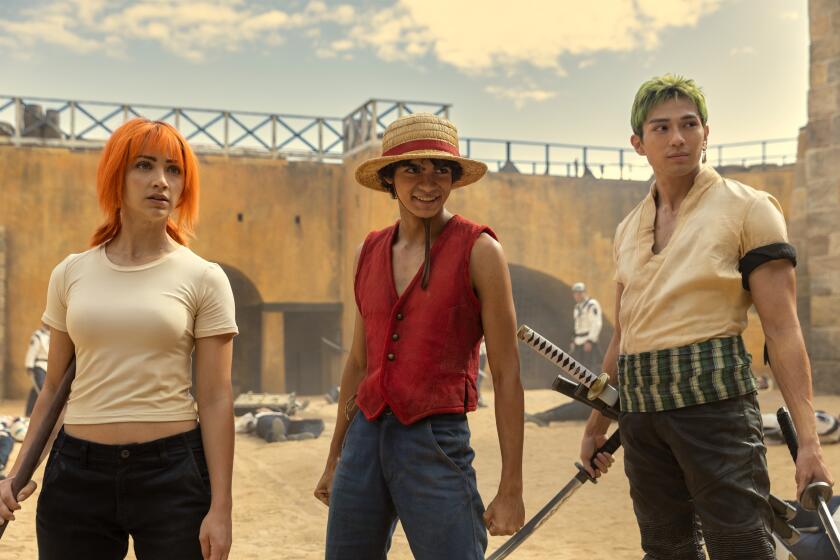‘Gum-gum’ limbs and flying feet: How Netflix’s ‘One Piece’ re-created four essential fight scenes

- Share via
In Eiichiro Oda‘s wildly imaginative, charmingly goofy and sprawling world of “One Piece,” combat is about more than just beating enemies to a pulp.
For the Straw Hat pirates — the rookie crew at the center of the manga series-turned-anime — heated moments with the corrupt World Government or big wig pirates are chances to use their powers toward grand ambitions.
Monkey D. Luffy whips out elastic attacks and battle stances (“gears”) to liberate long-oppressed communities across the seas and skies to become King of the Pirates. Sharpshooter Usopp tests out wacky slingshot ammo against daunting enemies like fishmen and man-eating plants to prove himself a brave warrior of the seas.
Fights are often whimsical but are the rewarding culmination of tear-jerking backstories and intricately planned world-building. Since the “One Piece” manga first released in 1997, Oda’s synthesis of action and emotion have endeared and awed generations of loyal fans. Now, the live-action series released by Netflix on Thursday tries to replicate some of the battles. The series was written by Matt Owens and Steven Maeda, who also serve as showrunners and executive producers. (Oda is also an executive producer, along with Marty Adelstein and Becky Clements.)
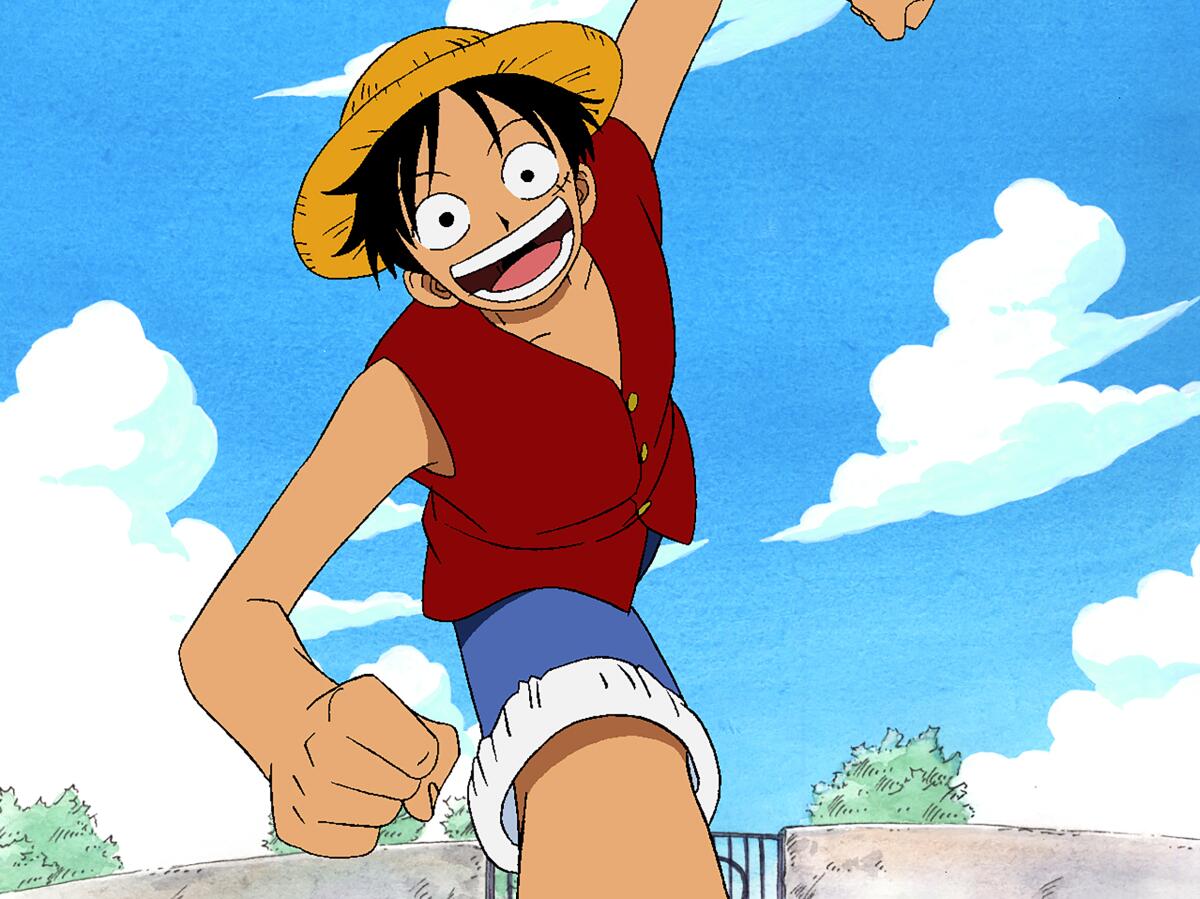
“[‘One Piece’] is one of those things so many people have invested so much of their life into,” said visual effects supervisor Victor Scalise. “We want to make sure that the fans are going to say, ‘OK, you guys tried to stay true to the universe as much as you can.’”
Whether it was the sweeping courtyard scene that introduces the first Straw Hats or the dramatic ruin of Arlong Park, the visual effects and stunt teams behind Netflix’s live action series worked closely to adapt the spirit of “One Piece” combat. Here’s how some of these essential Straw Hat fight scenes came together.
The (almost) Straw Hats vs. Capt. “Axe-Hand” Morgan!

A near five-minute stretch of high-energy acrobatics and over-the-top swordplay, the sandy courtyard fight in Episode 1 sets the tone for “One Piece” in more ways than one.
“We wanted to land for the audience that we weren’t pulling back on the action,” said Marc Jobst, who directed the episode. “Actually, we were going to go into it big time, and we were going to give it a different feel.”
After stealing the coveted map to the Grand Line, Luffy (Iñaki Godoy) and Nami (Emily Rudd) crash-land into a courtyard where a swarm of Capt. “Axe-Hand” Morgan’s (Langley Kirkwood) subordinates rush to capture them. For Jobst, this marks the start of a three-act arc that introduces the Straw Hats’ styles and brings them together as a team — whether they like it or not.
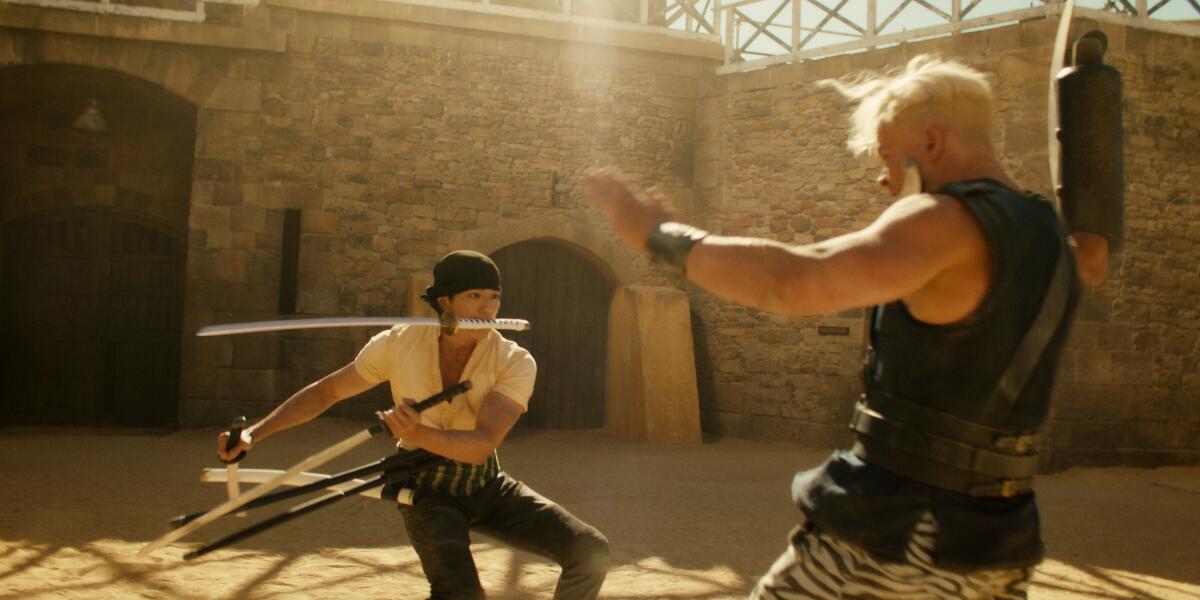
The courtyard scene was filmed over four days in 90-degree heat on a dirt lot in South Africa, said stunt coordinator Franz Spilhaus. The set-up included at least 40 stunt performers in Marine uniforms, wires, rigs and a camera operator closely tracking punches and kicks.
“It was a very big dance ... like a ballet,” Spilhaus said. Between Luffy barely missing a Marine’s sword or Nami lifting her bo staff in time to take out two foes at once, the courtyard scene has similar timing and rhythm of a dance.
Jobst said it was essential for the stars to be physically strong and present in most of the combat scenes so that they wouldn’t have to rely as heavily on stunt doubles and visual effects. Godoy, Rudd and Zoro actor Mackenyu each came to the project with different degrees of physical abilities but underwent additional training to suit their characters’ needs.
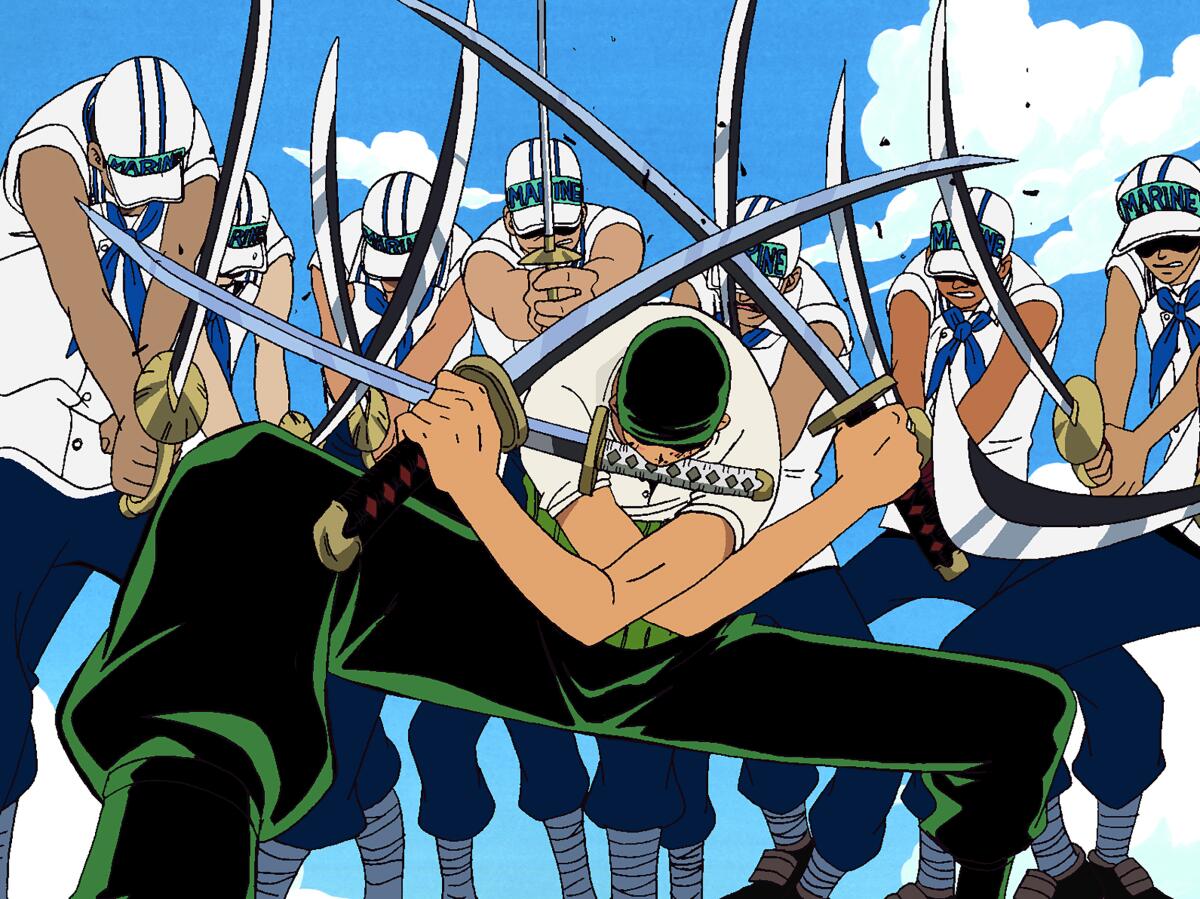
“We didn’t want to always bring [Luffy’s] rubber skills out. We wanted to make [Godoy] feel like he’s rubber by doing gymnastics, so you still get this emotional feeling of this guy who can just dance around wherever he wants,” Spilhaus added.
Just when Nami and Luffy are struggling to hold their own, Zoro takes out Marines by sliding on his knees and swinging two katanas. It’s a moment that leans into the camp of anime moves, and Spilhaus said the entrance was inspired by similar stunts from the 2022 Indian action film “Shamshera,” on which he served as action director.
In the second half of the courtyard scene, Luffy and Zoro’s abilities are front and center. They perform their signature moves, seemingly ripped from pages of the manga. It required months of preparation, numerous conversations and a close rapport between the stunts and visual effects teams.
Based on the manga series by Eiichiro Oda, ‘One Piece’ has aired more than 1,000 episodes since 1999. We asked the English voice cast to pick their favorites.
Re-creating Zoro’s iconic three-sword style — where he wields a third blade in his mouth — also required the guidance and expertise of Koji Kawamoto. The katana specialist said that Mackenyu (who is the son of late martial arts star and “Kill Bill” actor Sonny Chiba) worked his way from wielding one, to two, to three katanas. Each blade had its own choreography, Kawamoto said. Behind the scenes, Zoro’s mouth katana had a lightweight handle and a thin wire tipped with a blue Nerf foam bullet.
“If the katana is too heavy, it will wobble, and it might be a little bit dangerous,” Kawamoto said. “We had the CG team work their magic on that.”
For the “gum-gum” abilities Luffy gained from eating a rare power-granting Devil Fruit, which help his body stretch like rubber, it took Scalise, visual effects producer Scott Ramsey and their various vendors more than a year to perfect. “It’s a signature effect in all of the show, so it had to be right,” Ramsey said.
Eiichirô Oda’s popular and long-running manga has been turned into a live-action series on Netflix that stars Iñaki Godoy as Monkey D. Luffy.
Luffy’s gum-gum attacks — which he proudly calls out like in the anime — constantly evolved during the production. At first, Luffy’s movements were too solid and stiff to belong to a rubber human, Scalise said. After months of experimenting, Luffy’s elastic limbs started to come together when artists from FrameStore, a visual effects vendor, added more bend, weight and movement to a three-dimensional model, Scalise said.
Godoy’s body performance helped sell Luffy’s abilities too.
The combat sequence is also one of the most brightly lighted of the series, which allowed Scalise and Ramsey’s teams to nail down how Luffy’s powers would look in a real-world environment.
“If you can make it work in bright daylight, you’re probably in good shape everywhere else,” Scalise said.
The Straw Hats vs. Capt. Buggy’s ‘chop-chop’ fruit!

Like the budding Straw Hat crew, the “One Piece” team found victory and confidence in the Shells Town courtyard. Then came Buggy the Clown.
Self-centered, sadistic and unlike most normal circus clowns, Buggy (Jeff Ward) is also a Devil Fruit eater whose power allows him to disassemble and reassemble body parts on command. For Jobst, the big circus tent fight in Episode 2 “was a completely different beast” that required a variety of practical and technological approaches.
To capture the chaotic tornado of Buggy’s body parts, “One Piece” relied on fake limbs on sticks, wire work, a mechanism that would help Ward float and a sleeve used to mimic the pirate’s disembodied hand.
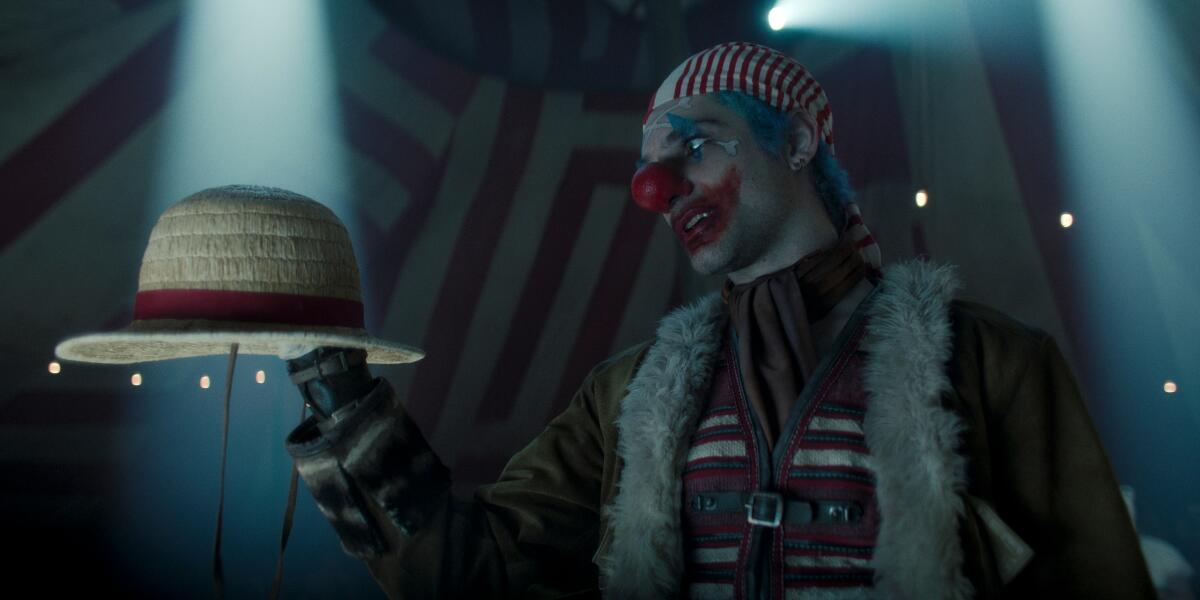
“It was really important to sell that [the limbs were] coming from all directions — different heights and different places, so it didn’t feel like all we’ve done is dress somebody up in a green suit,” Jobst said.
The physicality and effect of Buggy’s attacks were necessary to make the scene work, he added. They had the limbs on a stick hit Godoy, and Rudd also struck rogue prop limbs with her staff.
“If you don’t get those things right, it looks ... cheap, so it was really important we got the physicality,” Jobst said.
From the visual effects side, Scalise said Buggy’s combat needed pages of documents tracking limb placements, a convincing physical performance from Ward and a little bit of sneakiness. He said that the episode features discreet duplicates of certain body parts — like calves and shins — to add more movement to Buggy’s power.
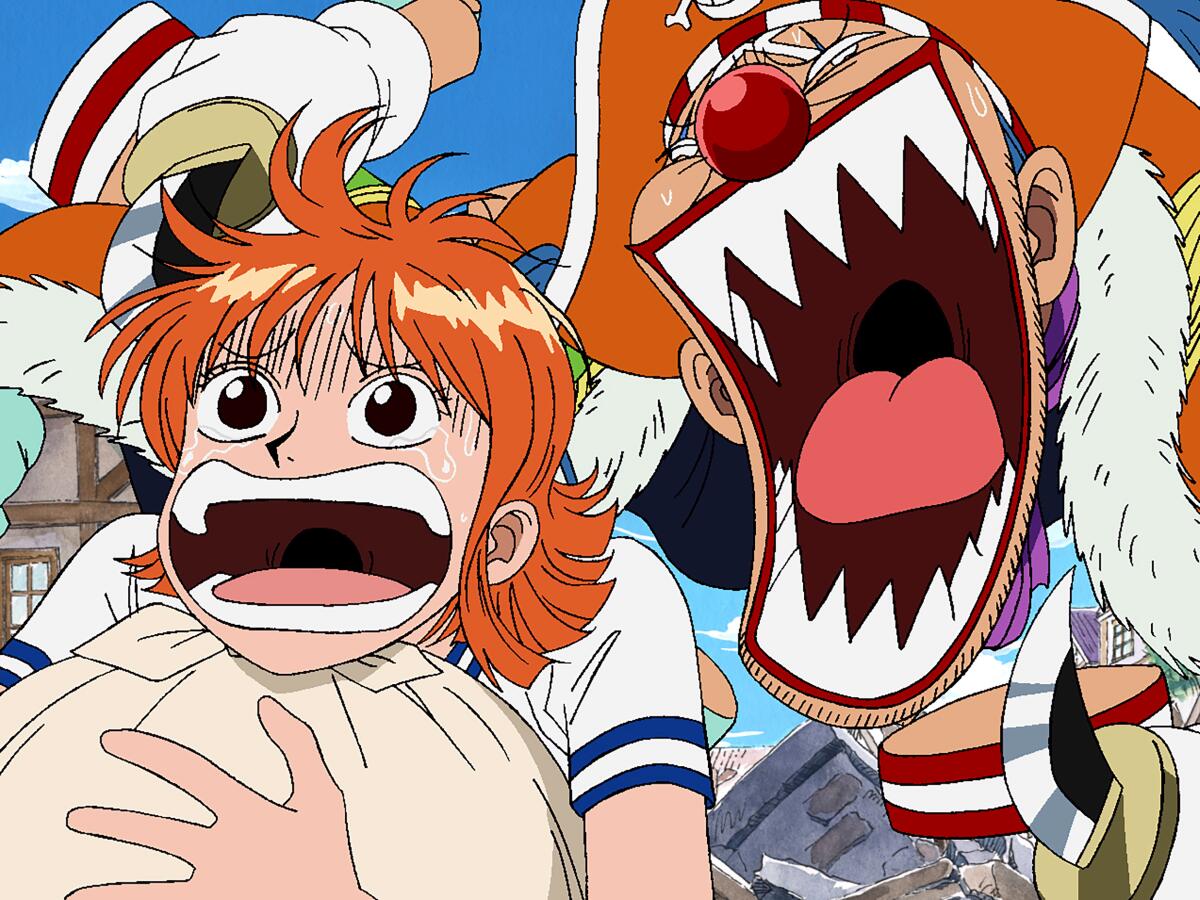
Scalise also said that the team worked to add personality to Buggy’s various body parts. As Buggy became more sadistic, his limbs were more aggressive with Nami and Zoro.
“There’s a lot of planned chaos that we put into the parts to help enhance the scene,” he said.
The Straw Hats vs. the Arlong Pirates! The fall of Arlong Park!

The Straw Hats’ resolve and strength are put to the test when they face feared fishman Arlong and his pirate crew in order to free Nami and her beloved hometown from his clutches. There’s fishman karate and new gum-gum attacks, but those weren’t the only focus for director Josef Wladyka.
“I was always looking to make sure we were not missing an emotional beat or a beat that doesn’t have anything to do with the crazy wire action,” he said.
Before filming, Wladyka said he worked with Owens, Maeda, cinematographer Trevor Michael Brown, storyboard artists and Spilhaus’ team to map out how the battles would look and feel. When it was time to capture the Straw Hats’ attack on Arlong Park on camera, nine cranes were used for the complex wiring, and dozens of stunt performers in different versions of fishmen prosthetics also came into the mix.

During the production of “One Piece,” Oda shared his opinions on what worked and what didn’t. The initial take on fishman karate — the humanoid beings’ combat style — fell into the latter, Scalise said.
At first, stingray Kuroobi (Jandre Le Roux) skipped over rocks in the pool to reach Zoro and newcomer Sanji (Taz Skylar). After hearing back from Oda, Scalise and Ramsey’s teams created a computer-generated clip of the fishman torpedoing through the water.

Inside the map room, which was built early in the production, Arlong (McKinley Belcher III) and Luffy engage in a desperate battle that replicates memorable panels from the manga and anime. “This is a crescendo, and we wanted to really pay homage to the material,” said Spilhaus.
Usual stunt mechanisms like rigs and wiring, and an intimidating physical performance from Belcher (who leaned into his boxing experience), were essential to the one-on-one, Spilhaus said. So were plaster of Paris and foam blocks that could easily crumble with Godoy’s punches.
“Real is better, as we always say,” he added.
The fight for Nami’s freedom and Cocoyashi Village ends with four words: “Gum-gum battle ax!”

The first version of the pivotal moment — a profile shot — wasn’t as destructive. Underwhelmed with the early renditions, Scalise said the visual effects team worked with Goodbye Kansas Studios to create a more dramatic shot that connects the top-down shot of Luffy’s final move to Arlong.
“You’re trying to tell the story of Luffy defeating Arlong, but also this story of Luffy wanting to destroy this place because it was Nami’s prison,” he said. “The pagoda itself is kind of a character in this whole piece.”
After the updated concept was presented to the showrunners and producers, Netflix allowed more money to go into the improved ending blow. “This is a big show; we need this ending to have this destruction,” Ramsey said.

More to Read
The complete guide to home viewing
Get Screen Gab for everything about the TV shows and streaming movies everyone’s talking about.
You may occasionally receive promotional content from the Los Angeles Times.

